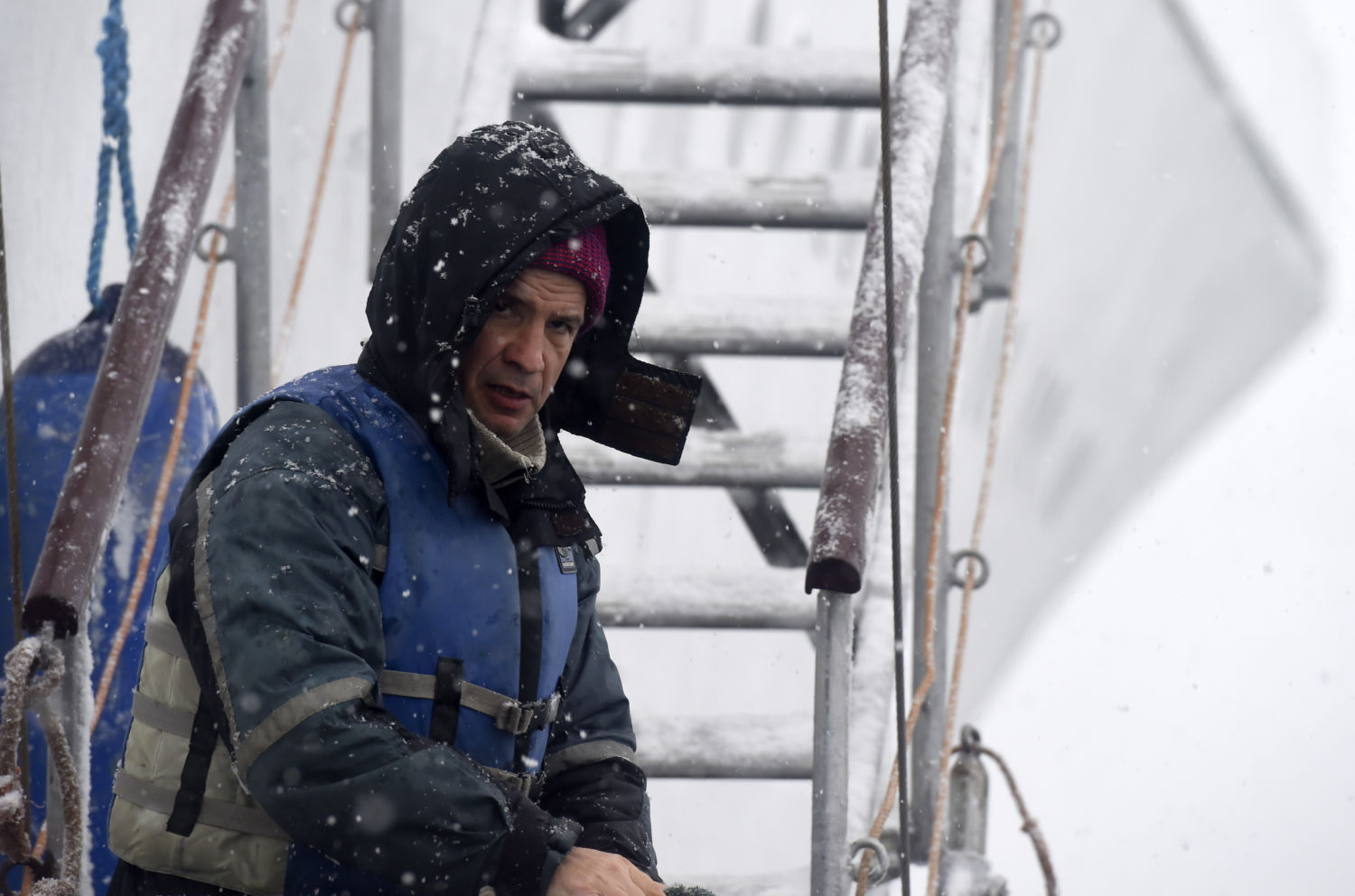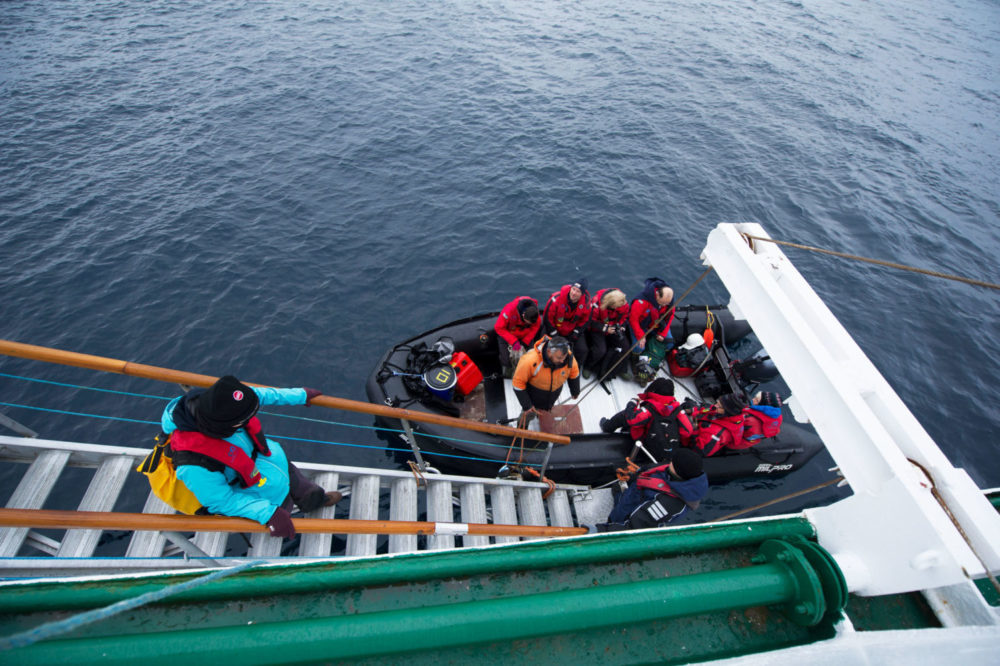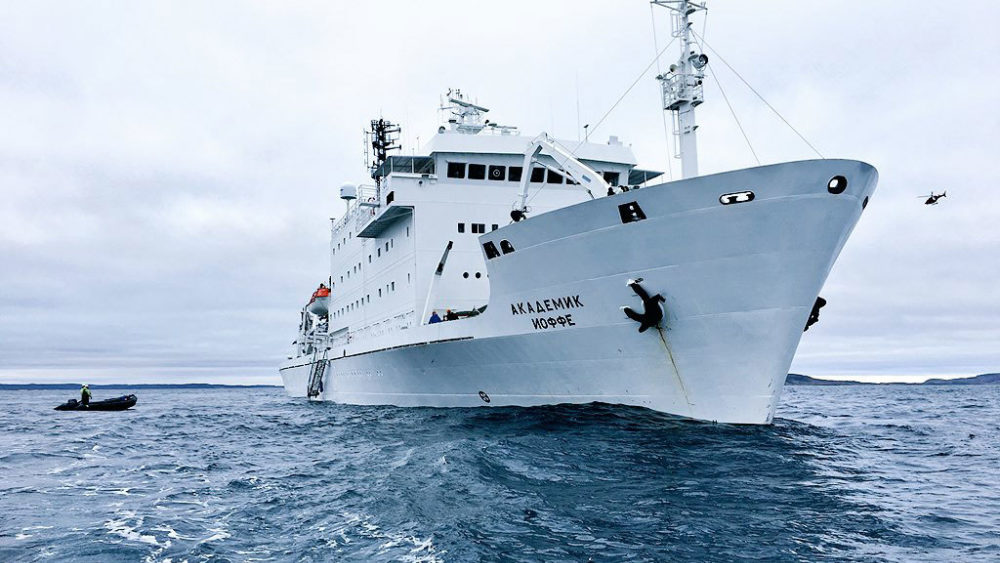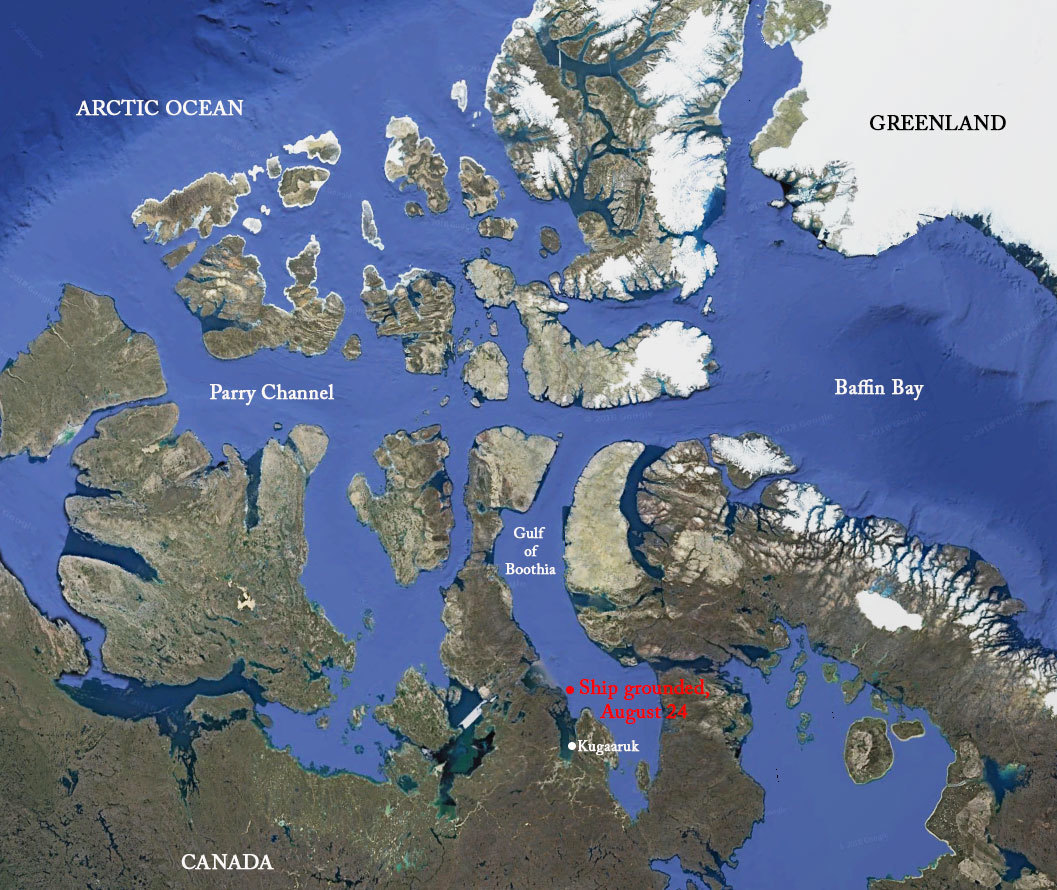Passengers aboard the Akademik Ioffe, a Russian research-cruise ship, in the Canadian Arctic in August, 2014.
Marion Kaplan / Alamy stock photo
From YaleEnvironment360 by Ed Struzik
On August 24, 2018, the Russian passenger vessel Akademik Ioffe ran aground with a shudder as it sailed through narrows in the Canadian Arctic.
I was aboard when the accident occurred in the remote Gulf of Boothia, an area not surveyed to adequate hydrographic standards and where none of the vessel’s crew had ever been before.
On board were 24 of us on a U.S. National Science Foundation-sponsored expedition, as well as 102 tourists and 37 crew members.
We knew the ship was in trouble, but we had no idea how bad things actually were until the Transportation Safety Board of Canada released a report two weeks ago.
Among other findings, the report says that the Russian crew had turned off the low-water depth alarms; that the captain immediately used the engines to try to refloat the vessel, a decision that went against standard practices because using propulsion could further open up a gashed hull; and that the ship’s officers wrongly informed passengers that the hull had not been breached and that the ship was not leaking oil.
Coming on the heels of the near-sinking of a Dutch ship carrying 350 tons of heavy oil in the Norwegian Sea last April, and 74 groundings that occurred in the Canadian Arctic from 2000 to 2018, the report underscores in chilling ways how a steady increase in shipping in a rapidly melting and largely uncharted Arctic could result in an environmental and human disaster.
“Until the coastal waters surrounding the Canadian Arctic Archipelago are adequately charted, and if alternate mitigation measures are not put in place, there is a persistent risk that vessels will make unforeseen contact with the sea bottom, putting passengers, crew, and the environment at risk,” the Transportation Safety Board investigators warned.
That warning could easily apply to the entire Arctic.
As shipping in this previously icebound region increases, maritime experts say, at the top of the list of concerns is the need for global and national standards requiring certified ice navigators — trained and experienced in the maneuvering of vessels in ice-covered waters — aboard all ships.
Added to that concern is the paucity of accurate navigational charts, which have yet to be made in many Arctic waters because of cost and the fact that sea ice conditions made it difficult to map the Arctic Ocean bottom until the last couple of decades.
Experts say these dual threats mean that the expected boom in Arctic shipping could well lead to maritime and environmental disasters.
So far, shipping in the Arctic has increased modestly in tandem with sea ice retreat.
According to the Arctic Council, the leading governmental forum promoting cooperation in the Arctic, ship traffic in the region grew by 25 percent between 2013 and 2019, from 1,298 ships to 1,628 ships. The total distance sailed by those ships grew by 75 percent in that same period, from 6.51 million nautical miles to 9.5 million nautical miles.
But economists and Arctic experts expect ship traffic to steadily accelerate with further melting and the rapid expansion of the world’s ice fleet.
Russia has more than 50 icebreakers and is building ports and encouraging shipping companies to use the Northeast Passage across the top of Siberia as a shortcut connecting the North Atlantic to the Pacific.
China, which has already explored all three polar routes — the Northwest Passage across Alaska and Canada, as well as the Northeast Passage and the Transpolar Route over the North Pole — recently announced plans to launch a satellite to monitor Arctic shipping routes.
The cruise ship, Crystal Serenity, sailed through the Northwest Passage in 2017 with 1,000 people aboard, a harbinger of the future growth of such tourism voyages.
It’s dangerous enough for ships to be sailing in a region like Arctic Canada and Alaska, where only 14 per cent and 4.1 percent, respectively, of the ocean has been surveyed to modern standards.Less ice actually brings greater hazards as the volume of shipping increases.
No ports exist in either northern Alaska or Arctic Canada from which a rescue could be staged or an oil spill cleaned up.
The East Siberian Sea, which is the shallowest of the seas along the Northern Sea Route and notorious for extreme temperatures and dangerous ice conditions, is even more perilous.
A 2018 study found that it has the highest risk in the Arctic for ship collisions, the sinking of ships, and ships running aground.
According to a recent report by the U.S. National Geospatial Intelligence Agency, “it is not possible to ensure that [nautical] charts and publications, covering the coasts of Russia and adjacent waters, are up to date concerning new dangers.”
The Akademik Ioffe after running aground on a shoal in the Canadian Arctic on August 24.
Donglai Gong
Maritime experts say that contrary to what many academics assert, the decline of sea ice is making shipping more dangerous, especially in areas like the Norwegian Sea — between Scandinavia and Greenland — where cruise ships, fishing boats and other vessels are stretching operational seasons and expanding navigation areas.
“Arctic shipping will not get safer as the ice diminishes,” said John Falkingham, secretariat of the International Ice Charting Working Group, which promotes coordination of sea ice and iceberg-information services.
“Since we first recognized the decline of sea ice, the watchword of Arctic mariners and ice experts was that less ice actually brings greater hazards to shipping.”
“Arctic shipping will not get safer as the ice diminishes,” said John Falkingham, secretariat of the International Ice Charting Working Group, which promotes coordination of sea ice and iceberg-information services.
“Since we first recognized the decline of sea ice, the watchword of Arctic mariners and ice experts was that less ice actually brings greater hazards to shipping.”
The Canadian Arctic region where the Akademik Ioffe ran aground.
Satellite observations show that the extent of Arctic summer sea ice has shrunk by roughly 40 percent since 1979, and that the volume of sea ice — based on thickness — has fallen by roughly two-thirds.
But the remaining ice, Falkingham said, is more mobile, allowing it to drift on wind and current.
This can create extreme pressure zones at port entrances, straits or passages, where ships have little room to maneuver and avoid ice that could damage or hole a ship.
“In high seas,” he added, “small multiyear ice floes can be thrown around, damaging anything they come in contact with — including ships.”
And it’s not just sea ice that presents a hazard, he said: “The ice caps are retreating across the Arctic, dropping more and more icebergs into the ocean.
The big, picturesque ones are not a problem for ships — but as they melt in the sea and become smaller and lower … they are a major hazard — hard as concrete and weighing tens of thousands of kilograms.
A ship coming in contact with one can easily be critically damaged.”
The term “ice-free,” according to Falkingham, is a misnomer.
“In the navigation world, ice-free means just that — no ice at all,” he said.
“But in the academic world, `ice-free’ typically means less than 15 percent ice concentration because the microwave satellite sensors used to monitor Arctic Ocean ice do not detect ice amounts lower than about 15 percent.
So the satellite doesn’t see it, and the scientist says it’s ice-free.
But if the navigator who charges ahead unknowingly is unlucky enough to hit a bit of the 15 percent, there could be a bad result.”
The good news is that the Arctic has not yet become the highway that some have predicted.
Shipping is increasing incrementally, and in most cases, with some degree of planning.
Most of these dangers can be avoided if there is an experienced ice navigator on board, as is recommended by the International Marine Organization (IMO) Polar Code.
The problem with the required Polar Water Certificate, according to David Snider, CEO of Martech Polar Consulting and a master mariner with 40 years’ experience sailing in polar regions, is that it falls short of the Nautical Institute’s ice navigator training requirements, the global gold standard in certification for polar navigation.
Valid Polar Waters certificates, which typically require several days of classroom time and ship simulator instruction at world-class facilities, can now be inexpensively secured with less classroom and simulator time from schools in places like the Bahamas.

A Russian crew member aboard the Akademik Ioffe in 2016
Eitan Abramovich / AFP via Getty Images
“A Polar Waters certificate can be obtained by a person who has never navigated through ice,” Snider said.
What’s needed, he added, is to tighten up the Polar Code, and failing that, “coastal states like Canada and the United States could simply change regulations requiring ships to have an experienced ice navigator on board.”
The grounding of the Akademik Ioffe underscores how inexperience and human error in the Arctic — issues not often discussed in the media since the Exxon Valdez spilled oil in Alaska’s Prince William Sound in 1989 — contributed to the 2018 emergency.
Russian crew members, according to the report, were “not closely monitoring the echo sounders, and the steady decrease of the under-keel water depth went unnoticed for more than four minutes, because the echo sounders’ low-water-depth alarms had been turned off.” When the ship’s officers realized the vessel was going to grind to a stop on the shoal, it was too late.
The Canadian report says the hull was breached in four places, flooding two fuel tanks and two ballast tanks.
The grounding also highlights how some shipping companies do not necessarily adhere to recognized seamanship practices.
Following a grounding, according to the report, attempts to refloat a vessel using the engines should only be made if the vessel is in immediate danger of sustaining a catastrophic structural failure, or if a breach in the hull is worsening.
Otherwise, attempting to refloat a vessel using propulsion can further damage a ship’s structure.
‘The more vessels there are, the greater the risks of air pollution and oil slicks and spills,’ said an expert.
But the checklist for the Akademik Ioffe stipulated that the captain must attempt to refloat the vessel with its engines.
The captain, who had sailed several times in the Arctic and Antarctic, did this before inspecting the underwater hull, activating the general alarm, or broadcasting a distress message.
Confusion, and in some cases panic, set in when the captain ignored requests to address the passengers directly, as is customary in an emergency.
In addition, a ship’s officer wrongly informed the expedition leader that the hull had not been breached and that no fuel had spilled, when it was obvious to those on board — from the sheen spreading across the water — that oil was leaking.
The report says the crew did not immediately call for assistance for an oil spill cleanup, rescue, or tow, as is typically done.
When the captain did call an hour after the grounding, the nearest available Canadian military Hercules aircraft was nine hours away.
Two Canadian Coast Guard vessels were 22 and 36 hours distant.
The nearest vessel was a Russian sister ship that had a full load of passengers and not enough safety gear for more than 100 additional passengers.
The vessel took 18 hours to get there.
If the Ioffe had begun to sink, the distant location of rescue vessels could have been disastrous.
Such problems could be magnified many times if large numbers of ships begin to transit the Arctic.
The Northeast and Northwest passages are already open for part of the summer.
And University of Hong Kong geographer Mia Bennet and colleagues recently published a study suggesting that a northern sea route directly over the North Pole could become navigable by mid-century.
“More ice-class vessels are being built — often in Chinese shipyards — to support gas development on the Yamal Peninsula [in Siberia] and resource extraction in northern Canada and Greenland,” Bennet said.
“The more vessels there are, the greater the risks of air pollution and oil slicks and spills.” In addition, she said, ice-breaking vessels could damage the ice on which many Arctic species rely, from walruses to polar bears.
Indigenous peoples, especially in the Bering Strait, still depend on many of these animals for subsistence.
Since it was established five years ago, the Clean Arctic Alliance, a coalition of 22 environmental organizations, has been pushing for a ban on shipping companies burning heavy fuel oil, which is viscous, inexpensive and dirty, as nations that are party to the Antarctic Treaty did a decade ago.
Switching to lighter, cleaner-burning fuel or liquified natural gas is more costly, but less likely to cause an environmental disaster.
“If heavy oil spills into cold Arctic waters, it will likely break down very slowly and prove to be almost impossible to clean up,” said Sian Prior, the lead advisor for the alliance.
She noted that heavy fuel oil also produces a considerable amount of black carbon, which contributes to climate warming, and that black carbon emissions from shipping increased by 85 percent from 2015 to 2019.
Some progress is being made.
Norway recently banned the use of heavy oil fuel in some waters around the Arctic archipelago of Svalbard.
The International Maritime Organization also has announced a ban on the use and transportation of heavy fuel oil in the Arctic that will take full effect by 2030.
Falkingham is currently organizing an international conference that will bring the world’s national ice services together again to coordinate activities to help make polar shipping safer.
As a testament to how little we know about the Arctic, as recently as 2003 the U.S. Coast Guard cutter, Healy, discovered an 6,561-foot seamount, or underwater mountain, north of Alaska.
As the Arctic opens to more ships, how many more seamounts and shoals are to be discovered — either benignly, as with the Healy, or less so, as with the grounding of the Akademik Ioffe?
Links :




No comments:
Post a Comment